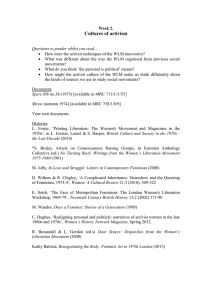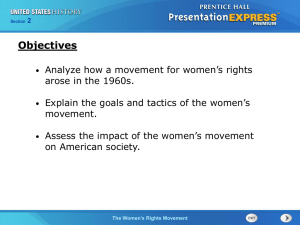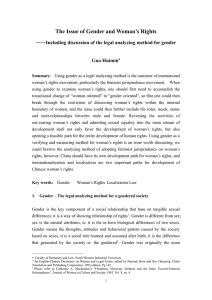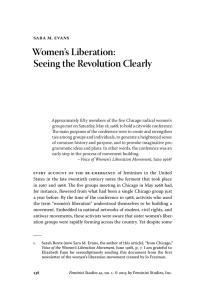women
advertisement
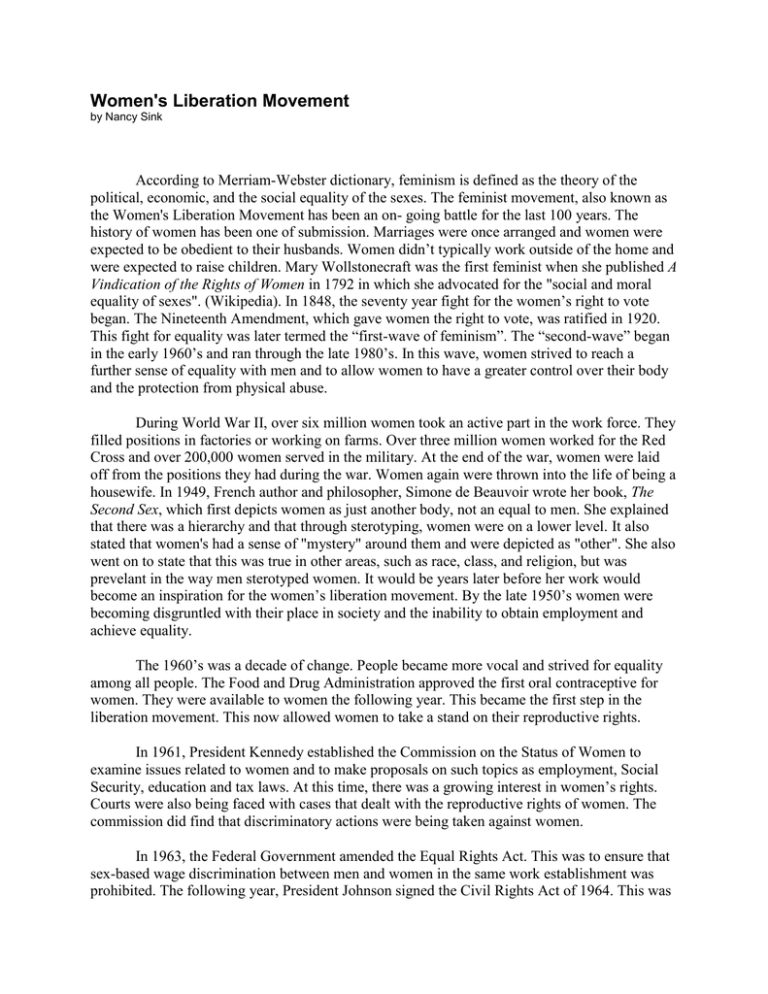
Women's Liberation Movement by Nancy Sink According to Merriam-Webster dictionary, feminism is defined as the theory of the political, economic, and the social equality of the sexes. The feminist movement, also known as the Women's Liberation Movement has been an on- going battle for the last 100 years. The history of women has been one of submission. Marriages were once arranged and women were expected to be obedient to their husbands. Women didn’t typically work outside of the home and were expected to raise children. Mary Wollstonecraft was the first feminist when she published A Vindication of the Rights of Women in 1792 in which she advocated for the "social and moral equality of sexes". (Wikipedia). In 1848, the seventy year fight for the women’s right to vote began. The Nineteenth Amendment, which gave women the right to vote, was ratified in 1920. This fight for equality was later termed the “first-wave of feminism”. The “second-wave” began in the early 1960’s and ran through the late 1980’s. In this wave, women strived to reach a further sense of equality with men and to allow women to have a greater control over their body and the protection from physical abuse. During World War II, over six million women took an active part in the work force. They filled positions in factories or working on farms. Over three million women worked for the Red Cross and over 200,000 women served in the military. At the end of the war, women were laid off from the positions they had during the war. Women again were thrown into the life of being a housewife. In 1949, French author and philosopher, Simone de Beauvoir wrote her book, The Second Sex, which first depicts women as just another body, not an equal to men. She explained that there was a hierarchy and that through sterotyping, women were on a lower level. It also stated that women's had a sense of "mystery" around them and were depicted as "other". She also went on to state that this was true in other areas, such as race, class, and religion, but was prevelant in the way men sterotyped women. It would be years later before her work would become an inspiration for the women’s liberation movement. By the late 1950’s women were becoming disgruntled with their place in society and the inability to obtain employment and achieve equality. The 1960’s was a decade of change. People became more vocal and strived for equality among all people. The Food and Drug Administration approved the first oral contraceptive for women. They were available to women the following year. This became the first step in the liberation movement. This now allowed women to take a stand on their reproductive rights. In 1961, President Kennedy established the Commission on the Status of Women to examine issues related to women and to make proposals on such topics as employment, Social Security, education and tax laws. At this time, there was a growing interest in women’s rights. Courts were also being faced with cases that dealt with the reproductive rights of women. The commission did find that discriminatory actions were being taken against women. In 1963, the Federal Government amended the Equal Rights Act. This was to ensure that sex-based wage discrimination between men and women in the same work establishment was prohibited. The following year, President Johnson signed the Civil Rights Act of 1964. This was to protect women from being discriminated against in the work environment. In 1965, the Equal Employment Opportunity Commissioners (EEOC) was appointed to enforce the Civil Rights Act. This; however, was not the case. Women were not being treated fairly in the workplace and the EEOC was unable to enforce the Civil Rights Act. So, in June 1966, while attending the Third National Conference on the Commission on the Status of Women in Washington, D.C., Betty Friedan and twenty-eight women founded the National Organization for Women (NOW). The purpose of the organization was “to take action to bring women into full participation in the mainstream of American society now, exercising all privileges and responsibilities thereof in true equal partnership with men”. As the year’s progressed, NOW’s membership grew. By the time the organization was incorporated in 1967, the membership numbers were at 1037. As membership grew, so did the demonstrations, rallies, petitions and such that were designed to facilitate the spread of information on the purpose of the group. They boycotted the 1968 Miss America Beauty Contest in Atlantic City to let it be known that women’s worth wasn’t about their appearance. NOW was readily involved in multiple law suits against companies that violated a woman’s right for equal opportunity employment. As a result of this hard work and dedication, they were a strong voice in having the Equal Rights Amendment revisited. It was no longer about the right to vote, but it became the battle to be recognized as a citizen and a person. By 1972, the Equal Rights Amendment had been approved by both houses of Congress and was sent to be ratified by the states. This was a big step towards women’s liberation. The National Organization for Women continued its work for women’s rights. Task forces were created in support of the right to an abortion and protection for victims of rape. New legislation, as a result of court cases supported by NOW, was presented to protect the victim in a physical assault case. One such case was that of Joanne Little, in 1975. Ms. Little was in prison on a felony breaking and entering and larceny. While in prison, she was sexual assaulted by another prisoner and, in self-defense, killed her attacker. She was acquitted of this charge which set a precedent for victims of sexual assault. By the end of 1979, the National Organization for Women’s membership numbers was 100,000 members strong. In 2008, NOW has 500,000 members and 550 chapters in all 50 states and the District of Columbia. The organization is still fighting for the rights of women and ensuring that the organization stays true to the ideals of its founding members.



